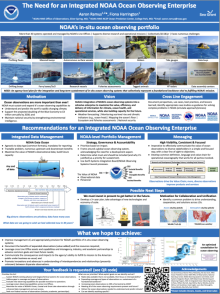The Need for an Integrated NOAA Ocean Observing Enterprise
Aaron
Ramus
NOAA NWS Office of Observations & Ocean Prediction Center
Poster
NOAA invests nearly half a billion dollars annually collecting, transmitting, and processing in-situ ocean, coastal, and Great Lakes observations located at the ocean boundary and throughout the water column using different types of instruments. This in-situ ocean observing network supports diverse research and operational missions, and includes more than 40 systems operated and managed by multiple NOAA Line Offices. The long-term sustainment of this network is challenged with flatline funding coupled with rising costs due to inflation and supply chain costs. However, there is no agency-level plan for the long-term sustainment of these in-situ ocean observing systems that collectively represent a foundational backbone vital to fulfilling NOAA’s mission. This comes at a time when ocean observations are more important than ever: there is a pressing imperative to sustain and expand NOAA’s ocean observing capabilities in order to (i) understand and predict the earth’s rapidly changing climate, (ii) support the projected doubling of the Blue Economy (to $3 trillion annually by 2030), and (iii) maintain national security by strengthening environmental intelligence and protecting critical information from growing threats. NOAA is starting to develop a plan for a more holistic review of requirements and needs for its in-situ ocean observing systems to maximize the value, efficiency, and delivery of information for climate, ocean health, and operational services, while also building capacity for the future. Achievement of an integrated enterprise will enable NOAA to (i) improve management and appropriately provision for its portfolio of in-situ ocean observing systems (similar to satellites and aircraft); (ii) document the benefits of expanded observations (value added) and the resources required; (iii) leverage cross line office assets and interagency, industry, and academic partnerships to meet future needs; (iv) communicate the consequences and impacts to the agency’s ability to fulfill its mission to the American public under business-as-usual; and (v) promote innovations and advances in understanding of interdependencies and relationships (presently unknown) between disparate observations.

